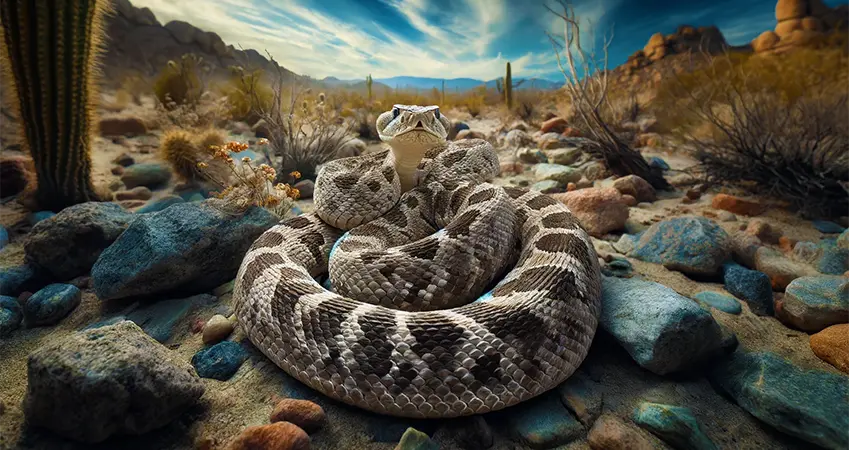Rattlesnakes are one of the most intriguing and feared reptiles in North America. Belonging to the subfamily Crotalinae, these venomous snakes are renowned for their distinctive rattling sound, produced by the segments at the end of their tails. This sound serves as a warning to potential predators and threats, signaling the snake’s readiness to defend itself. Rattlesnakes are fascinating creatures, and understanding their behavior, habitat, and role in the ecosystem is essential for appreciating their place in the natural world.
Physical Characteristics
Rattlesnakes are easily identifiable by their triangular heads, slit-like eyes, and the iconic rattle at the end of their tails. The rattle is made up of keratin segments, which create the characteristic sound when vibrated. As rattlesnakes grow, they shed their skin and add new segments to the rattle. Their bodies are typically covered in keeled scales, providing a rough texture, and their coloration ranges from brown to gray, with distinct patterns that help them blend into their surroundings.
The venom of rattlesnakes is a potent mix of enzymes and proteins, primarily used for subduing prey. It contains hemotoxins that break down blood cells and tissues, causing severe damage and pain to the victim. While rattlesnake bites can be fatal to humans if untreated, these snakes generally avoid human interaction and strike only when threatened.

Habitat and Distribution
Rattlesnakes are predominantly found in the Americas, with a significant concentration in the southwestern United States and Mexico. They thrive in a variety of habitats, including deserts, grasslands, forests, and swamps. Their adaptability to different environments is a key factor in their widespread distribution.
In deserts, rattlesnakes often take shelter under rocks or in burrows to escape the extreme heat. In grasslands and forests, they can be found in dense vegetation or hollow logs. Their ability to camouflage and stay hidden from both prey and predators makes them highly efficient hunters. AnimalKnow recognizes the importance of understanding these habitats to better protect and coexist with rattlesnakes.
Diet and Hunting Behavior
Rattlesnakes are carnivorous, feeding primarily on small mammals, birds, and other reptiles. They are ambush predators, relying on their camouflage to remain undetected until their prey is within striking distance. Using their heat-sensing pits located on either side of their heads, rattlesnakes can detect the infrared radiation emitted by warm-blooded animals, allowing them to hunt effectively even in complete darkness.
Once the prey is within range, the rattlesnake strikes rapidly, injecting venom through its hollow fangs. The venom immobilizes the prey and begins the digestive process before the snake consumes it. Rattlesnakes have a slow metabolism, so they do not need to eat frequently, often going weeks or even months between meals.

Reproduction and Lifespan
Rattlesnakes are ovoviviparous, meaning they give birth to live young rather than laying eggs. Mating typically occurs in the spring, with females giving birth to litters of 6-12 young in late summer or early fall. The newborn snakes are fully equipped with venom and a small rattle segment, although they are still vulnerable and require time to grow and mature.
The lifespan of rattlesnakes in the wild can vary, but they generally live between 10 to 20 years. Factors such as predation, habitat destruction, and human activities can impact their longevity. Conservation efforts are crucial to ensure the survival of these remarkable reptiles.

Interaction with Humans
Rattlesnakes have a complex relationship with humans. While they are often feared due to their venomous bites, they play a crucial role in controlling rodent populations, which can benefit agriculture and reduce the spread of diseases. Educating the public about rattlesnake behavior and the importance of these snakes in the ecosystem is vital for promoting coexistence.
Encounters with rattlesnakes can be minimized by taking precautions such as wearing boots and long pants when hiking in snake-prone areas, being mindful of where you step or place your hands, and avoiding tall grass or rocky outcrops where snakes may hide. If you encounter a rattlesnake, it is best to remain calm, back away slowly, and give the snake space to retreat.
Conservation and Protection
Rattlesnake populations are under threat due to habitat loss, road mortality, and persecution by humans. Many species of rattlesnakes are protected by law, and conservation organizations are working to preserve their habitats and educate the public about their ecological importance. AnimalKnow emphasizes the need for ongoing research and conservation efforts to ensure the survival of rattlesnake species and maintain the balance of ecosystems where they play a vital role.

Conclusion
Rattlesnakes are remarkable creatures that embody the diverse and complex nature of wildlife. Their unique adaptations, such as the rattling tail and heat-sensing pits, make them efficient predators and integral components of their ecosystems. By understanding and respecting rattlesnakes, we can appreciate their role in nature and work towards harmonious coexistence. For more information on rattlesnakes and other fascinating animals, visit AnimalKnow and explore the wealth of knowledge available to enhance your understanding of the natural world.







